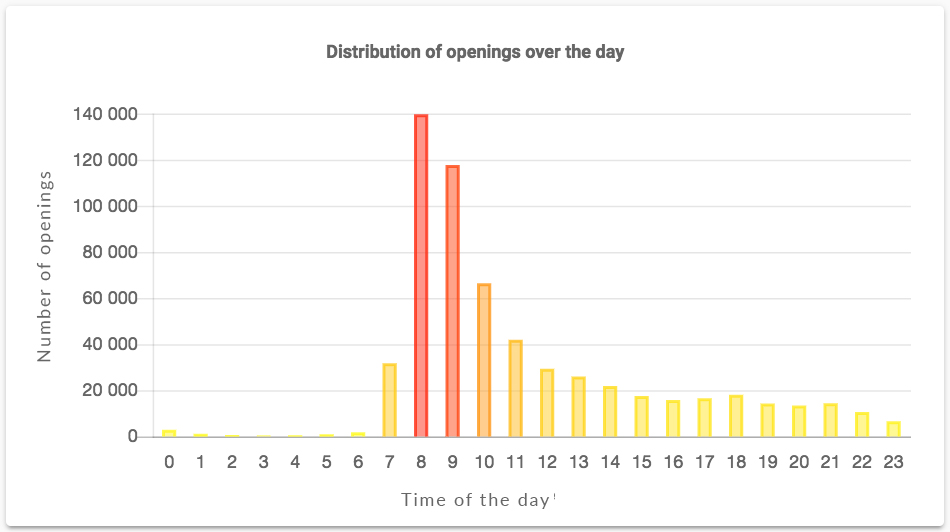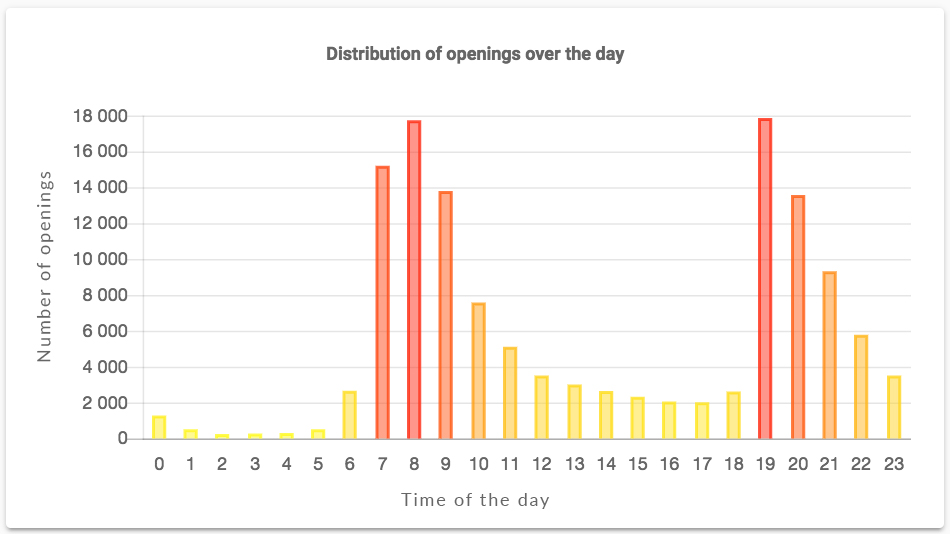What is the best time to send your newsletters?
Most of the times, emailing campaigns are sent exactly on the same days of the week and at the same time. However this does not necessarily result from a well thought strategy. While many marketing teams run many A/B tests to figure out which day at what time they should send their newsletters to optimize the open rate or the click, they too often lack time and expertise to update their strategy. Instead they rely on online studies, that unfortunately do not always match their company needs. For instance, a restaurant owner will more likely optimize its open rate if the newsletters are sent around lunchtime, while an online newspaper should probably send theirs early in the morning before the readers start to work. Such studies need indeed to be taken with a grain of salt and one should check out their veracity. Let me now tell you how you can optimize the metrics mentioned above by personalizing the time at which you send out your emailing campaigns for performing so that it perfectly match your readers ‘habits.
Why should you optimize the sending time of your newsletters?
You should optimize the time at which you send out your newsletters for many reasons such as:
- To reduce the marketing pressure: most marketing teams follow the same online studies in order to set the time at which their newsletters are sent. However, you are obviously not the only one on the market in your sector of activity that follows the rules set by such studies. For instance, if it has been shown that you will get a better customer engagement if you send your newsletters between 9 am and 10 am in the online media world, you won’t be the only one to pick up that very time. This yields your readers to potentially receive several newsletters at the same time and strongly feel the marketing pressure. This could lead to subscription cancellations, which is precisely what you want to avoid.
- To deliver the best possible user experience: for a long time, marketing rules consisted in imposing the brand vision that customers had to adapt to. This is now over: clearly your brand has to adapt its way of communicating to the customers’ habits.
- To improve the performances of your newsletters: if your readers receive your newsletter precisely when they are ready to afford some time for you, your performance will increase in terms of open rate, click rate and reactivity rate. This will have a significant and direct impact for instance on the way you monetize advertising if your are in online
- To save time while being efficient: we will come back to that later, but most of the time, optimizing the sending time of the newsletter is not achieved manually but managed by an algorithm that a more powerful analysis capacity and is much faster than humans.
How to automatically optimize the sending time of your newsletters?
As setting up manually the optimal time to send out your newsletters is almost impossible, let me now tell you why automating the process with the help of an algorithm is your best friend.
- Let the data speak: to do this, nothing simpler, pick up a sending time and keep for the duration of the test. Keep in mind that you have to test for a long enough period to get anything out of you experiment. Actually, the longer the data collection period, the more reliable the results. Another important point is obviously the size of the database. Typically, a database with 1,000 subscribers will require the test to run for a longer period of time to obtain significant results than a 100,000 subscriber database. To conduct this first test, you should probably try to send the newsletters at the time of the day where your website attracts the biggest number of readers. This is probably a time where the majority of your subscribers are inclined to read you.

Here is for instance the figures that our customers can get from the Mediego dashboard. On the figure above, you can observe 2 peak hours of opening which are actually very close to the sending time (between 7am and 8am in this experiment). This suggests that readers are more likely to read their newsletter soon after having receiving it. Yet, a significant portion of the readers open their newsletter between 10 am and 11 am (around 100,000 openings). After that, the number of openings continues to be diluted during the day. By spreading the sending time of newsletters over the day, the performances may be improved.
- Run A/B tests: by looking at the data related to your previous campaigns, your mailer should be able to provide you with a way to customize the sending hours. Before activating this functionality though on your entire database, I suggest you run A/B tests. An A/B test consists in splitting your database (or a portion of your database) in two (potentially more if you want to test more than two sending times) and proceed as follows. The first half of the database will receive the newsletter at a fixed time (preferably at the same time as usual). The subscribers of second half of the database, will receive their newsletter at a different time, for instance chosen according to on their habits collected during the previous step. Again, the longer you run your test, the more reliable the results.

In this example of a newsletter, usually sent in the morning (between 7 and 8 am), we observe better results in terms of openings early in the evening. This clearly shows that personalizing the sending time might boost your performance.
- Analyze the results and update carefully your strategy: If the results are in favor of personalization, try to progressively extend the personalization of sending time to your whole database. However, if the results do not show any improvement, conduct new A/B tests on various sending time, or different sample of subscribers to see if there is any change. You can also conclude that you managed to beat the algorithm (and Lee Sedol jealous in the process!).
At Mediego, we are working hard to personalize the entire user experience of your readers. If you want lear more and see Mediego in action, just ask us!


